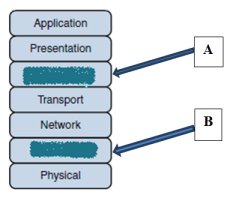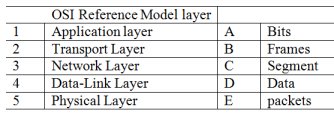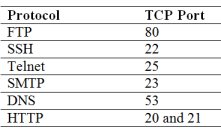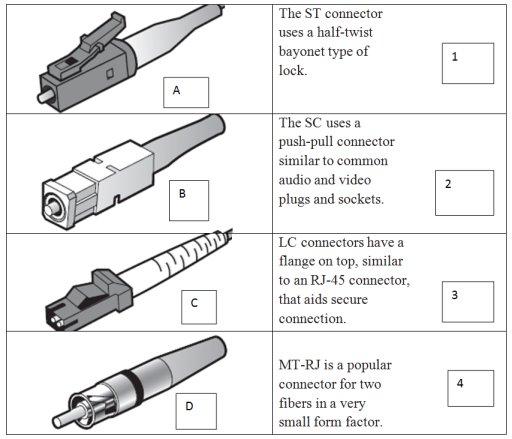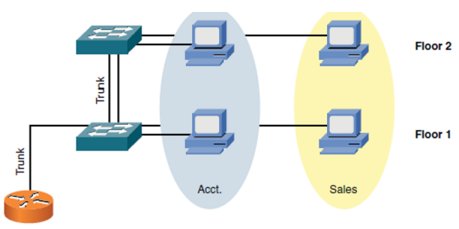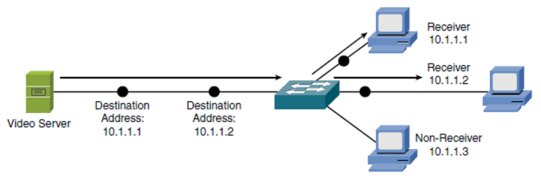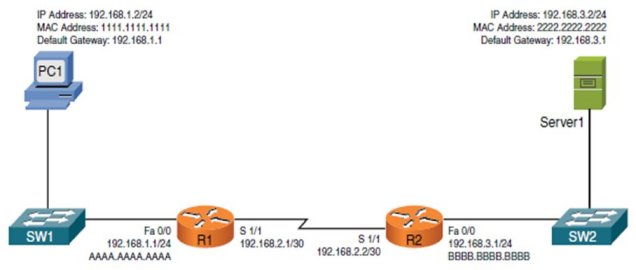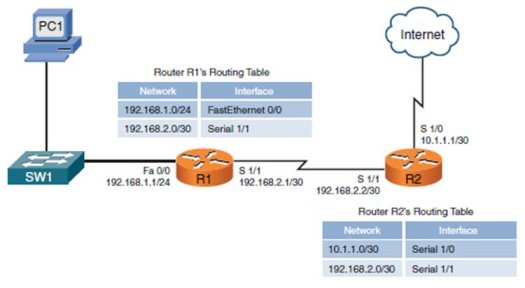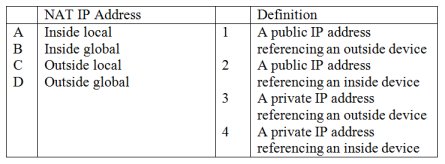Geographical Dispersion Of Network Components
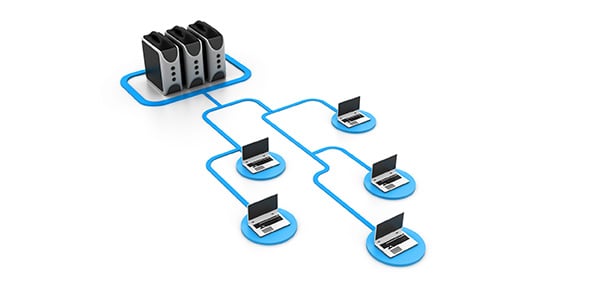
- 1.
To accomplish DNAT, a gateway performs PAT (Port Address Translation). With PAT each client session with a server on the Internet is assigned a separate TCP port number. When the client issues a request to the server, its datagram’s source address includes this port number. When the Internet server responds, its datagram’s destination address includes the same port number. This allows the gateway to send the response to the appropriate client. PAT is the most common type of address translation used on small office and home networks.
- 2.
Which of the following is NOT an example of an application that can travel over a network's connections?
- A.
Voice over IP (VoiceIP)
- B.
Email
- C.
Instant Messaging (IM) between computers with IM software installed
- D.
File sharing between computers
- E.
Local Area Network
Correct Answer
E. Local Area NetworkExplanation
A Local Area Network (LAN) is not an example of an application that can travel over a network's connections. A LAN is a network that connects computers and devices within a limited area, such as a home, office, or building. It is a network infrastructure rather than an application itself. Voice over IP (VoiceIP), email, instant messaging, and file sharing are all examples of applications that can utilize a network's connections to transmit data or communicate between devices.Rate this question:
-
- 3.
Which of the following is a NOT a network category based on the geographical dispersion of network components?
- A.
Local-Area Network (LAN)
- B.
Campus Area Network (CAN)
- C.
World area network (WAN)
- D.
Personal Area Network (PAN)
- E.
Metropolitan Area Network (MAN)
Correct Answer
C. World area network (WAN)Explanation
The given options represent different network categories based on the geographical dispersion of network components. A Local-Area Network (LAN) is a network that covers a small area, typically within a single building or campus. A Campus Area Network (CAN) is a network that covers multiple buildings within a limited geographical area, such as a university campus. A Metropolitan Area Network (MAN) is a network that covers a larger area, such as a city or metropolitan area. A Personal Area Network (PAN) is a network that connects devices within an individual's personal space, such as Bluetooth devices. However, a World Area Network (WAN) is not a network category based on geographical dispersion, but rather refers to a network that covers a wide area, such as connecting multiple LANs or MANs across different locations.Rate this question:
-
- 4.
A converged network is a network that has the capabilities of transporting multiple types of traffic such as voice, video, and data, which can offer significant cost savings to organizations.
- A.
True
- B.
False
Correct Answer
A. TrueExplanation
A converged network refers to a network that can handle various types of traffic, including voice, video, and data. This capability allows organizations to transmit all these types of information over a single network infrastructure, leading to cost savings. By consolidating different types of traffic onto one network, organizations can reduce the need for separate networks for each type of communication. This not only simplifies network management but also reduces hardware and maintenance costs. Therefore, the statement that a converged network can offer significant cost savings to organizations is true.Rate this question:
-
- 5.
IEEE stands for the Institute of Electrical and Electronics Engineers, and it is an internationally recognized standards body
- A.
True
- B.
False
Correct Answer
A. TrueExplanation
IEEE stands for the Institute of Electrical and Electronics Engineers, which is a globally recognized organization that sets standards in the field of electrical and electronics engineering. They develop and publish technical standards, organize conferences, and provide resources for professionals in the industry. Being internationally recognized, IEEE plays a crucial role in shaping the development and advancement of technology in various sectors. Therefore, the statement that IEEE is an internationally recognized standards body is true.Rate this question:
-
- 6.
When interconnecting multiple sites (for example, multiple corporate locations) via WAN links, a hub-and-spoke topology has a WAN link from each remote site , a spoke site) to the main site , the hub site). The diagram below shows a hub-and-spoke topology.
- A.
True
- B.
False
Correct Answer
A. TrueExplanation
The explanation for the given correct answer, which is True, is that in a hub-and-spoke topology, multiple sites are interconnected via WAN links. Each remote site, also known as a spoke site, has a WAN link to the main site, also known as the hub site. This allows for centralized communication and management, as all traffic flows through the hub site. This topology is commonly used in scenarios where there is a central location that needs to communicate with multiple remote locations.Rate this question:
-
- 7.
Which of the following applies to client-server network? (Choose 2)
- A.
Administration of client-server is more difficult than in a peer-to-peer network since the resources are located on one or more servers.
- B.
Client-server networks are NOT commonly used by businesses.
- C.
Client-server networks can have better performance than a peer-to-peer network because their resources can be located on dedicated servers rather than on a PC running a variety of end-user applications.
- D.
The diagram below represents a client-server network.
- E.
The diagram below represents a client-server network.
Correct Answer(s)
C. Client-server networks can have better performance than a peer-to-peer network because their resources can be located on dedicated servers rather than on a PC running a variety of end-user applications.
E. The diagram below represents a client-server network.Explanation
The first statement explains that the administration of a client-server network is more difficult than in a peer-to-peer network because the resources are located on one or more servers. This means that managing and controlling the network and its resources requires more expertise and effort compared to a peer-to-peer network. The second statement explains that client-server networks can have better performance than a peer-to-peer network because their resources can be located on dedicated servers. This means that the dedicated servers can provide faster and more efficient access to resources compared to a PC running multiple end-user applications. The diagram represents a client-server network, visually illustrating the concept.Rate this question:
-
- 8.
Which of the following is NOT a layer of the Open Systems Interconnect (OSI) reference model?
- A.
Physical Layer
- B.
Data Link Layer
- C.
Presentation Layer
- D.
Internet Access Layer
Correct Answer
D. Internet Access LayerExplanation
The Internet Access Layer is not a layer of the OSI reference model. The OSI model consists of seven layers: Physical, Data Link, Network, Transport, Session, Presentation, and Application. The Internet Access Layer is not part of this model and is not recognized as a standard layer in the OSI reference model.Rate this question:
-
- 9.
What layers of the OSI correspond to labels A and B?
- A.
A is session layer and B is application.
- B.
A is session layer and B is Physical.
- C.
A is Host-to-Host layer and B is Internet access layer.
- D.
A is session layer and B is data-link layer.
Correct Answer
D. A is session layer and B is data-link layer. -
- 10.
The term packet is used fairly generically to refer to a protocol data unit (PDU). However, a PDU might have additional names based on its OSI layer. What is the name of the PDU in the physical layer of the OSI reference Model?
- A.
Segmen
- B.
Packet
- C.
Bits
- D.
Frames
Correct Answer
C. BitsExplanation
In the physical layer of the OSI reference model, the PDU is called "Bits". The physical layer deals with the actual transmission of data over a physical medium, such as cables or wireless signals. At this layer, the data is represented as individual bits, which are the smallest unit of data. Therefore, "Bits" is the correct answer for the PDU in the physical layer.Rate this question:
-
- 11.
Which of the following matching is true concerning the Protocol Data Unit (PDU) and its corresponding OSI layer location?
- A.
1A, 2B, 3C, 4D, 5E
- B.
1D, 2A, 3E, 4B, 5C
- C.
1D, 2E, 3C, 4B, 5A
- D.
1D, 2C, 3E, 4B, 5A
Correct Answer
D. 1D, 2C, 3E, 4B, 5A -
- 12.
Which of the following layers of the OSI reference model is primarily concerned with forwarding data based on logical addresses?
- A.
Data Link Layer
- B.
Physical Layer
- C.
Network Layer
- D.
Presentation Layer
Correct Answer
C. Network LayerExplanation
The Network Layer of the OSI reference model is primarily concerned with forwarding data based on logical addresses. This layer is responsible for routing and addressing, ensuring that data packets are properly directed to their destination based on logical addresses, such as IP addresses. The Network Layer also handles congestion control, error handling, and fragmentation of data packets.Rate this question:
-
- 13.
Switching is associated with Layer 2 (data link layer) and Layer 3 (network layer)
- A.
True
- B.
False
Correct Answer
A. TrueExplanation
Switching is indeed associated with both Layer 2 (data link layer) and Layer 3 (network layer) in networking. At Layer 2, a switch operates by using MAC addresses to forward data packets within a local network. It learns and stores MAC addresses in its forwarding table to make forwarding decisions. At Layer 3, a switch can also perform routing functions by using IP addresses to forward packets between different networks. This allows the switch to connect multiple local networks and route traffic between them. Therefore, the statement "Switching is associated with Layer 2 and Layer 3" is true.Rate this question:
-
- 14.
Which of the following transport layer protocol of the OSI reference model is a connection-oriented protocol that provides reliable transport between two communicating hosts?
- A.
User datagram Protocol (UDP)
- B.
Transport Control Protocol (TCP)
- C.
Internetwork Packet Exchange (IPX
- D.
Transmission Control Protocol (TCP)
Correct Answer
D. Transmission Control Protocol (TCP)Explanation
TCP is a connection-oriented protocol that provides reliable transport between two communicating hosts. It establishes a connection between the sender and receiver before data transmission and ensures that all data packets are received in the correct order and without any errors. TCP also includes mechanisms for flow control and congestion control to optimize data transmission. UDP, on the other hand, is a connectionless protocol that does not guarantee reliable delivery of data. IPX is a network layer protocol, not a transport layer protocol.Rate this question:
-
- 15.
Which of the following protocol to TCP port matching is correct?
- A.
ftp 20 and 21, SSH 22, Telnet 23, SMTP 25, DNS 53, HTTP 80
- B.
Ftp 20 and 23, SSH 22, Telnet 25, SMTP 25, DNS 53, HTTP 80
- C.
Ftp 20 and 21, SSH 22, Telnet 25, SMTP 23, DNS 53, HTTP 80
- D.
Ftp 20 and 21, SSH 23, Telnet 25, SMTP 25, DNS 80, HTTP 53
Correct Answer
A. ftp 20 and 21, SSH 22, Telnet 23, SMTP 25, DNS 53, HTTP 80Explanation
The correct answer is ftp 20 and 21, SSH 22, Telnet 23, SMTP 25, DNS 53, HTTP 80. This answer correctly matches the protocols to their respective TCP ports. FTP uses ports 20 and 21, SSH uses port 22, Telnet uses port 23, SMTP uses port 25, DNS uses port 53, and HTTP uses port 80.Rate this question:
-
- 16.
Which OSI reference model layer is responsible for?(a) Setting up a session(b) Maintaining a session(c) Tearing down a session
- A.
Session Layer (Layer 5)
- B.
Data-Link Layer (Layer 2)
- C.
Presentation Layer (Layer 6)
- D.
Transport Layer (Layer 4)
Correct Answer
A. Session Layer (Layer 5)Explanation
The Session Layer (Layer 5) in the OSI reference model is responsible for setting up, maintaining, and tearing down a session. It establishes and manages the connection between two communicating devices, allowing them to exchange data. This layer handles session establishment, synchronization, and termination, ensuring that the communication between the devices remains reliable and error-free. It also manages session checkpoints, allowing for the recovery of data in case of interruptions or failures.Rate this question:
-
- 17.
At layers above the Physical layer in the OSI Reference Model, bits are grouped together into a Protocol Data Unit (PDU)
- A.
True
- B.
False
Correct Answer
A. TrueExplanation
At layers above the Physical layer in the OSI Reference Model, bits are grouped together into a Protocol Data Unit (PDU). This means that the data transmitted at these layers is organized into a specific format or structure, known as the PDU. The PDU contains the necessary information for the layer to function properly and communicate with other layers. This grouping of bits into PDUs allows for more efficient and organized data transmission and processing at higher layers of the OSI model.Rate this question:
-
- 18.
Which two types of media are twisted-pair cable?
- A.
RJ-11 and RJ-45
- B.
STP and UTP
- C.
RG-59 and RG-58
- D.
MMF and SMF
Correct Answer
B. STP and UTPExplanation
STP and UTP are the correct answers because they both refer to types of twisted-pair cables. STP stands for Shielded Twisted Pair, which has an additional layer of shielding to protect against electromagnetic interference. UTP stands for Unshielded Twisted Pair, which does not have the extra shielding. Both STP and UTP cables are commonly used in Ethernet networks for transmitting data. RJ-11 and RJ-45 are types of connectors used with twisted-pair cables, while RG-59 and RG-58 are types of coaxial cables, and MMF and SMF are types of fiber optic cables.Rate this question:
-
- 19.
How fast can category 5e transfer data?
- A.
1000 mbps
- B.
10 mbps
- C.
100 mbps
- D.
10 gbps
Correct Answer
A. 1000 mbpsExplanation
Category 5e cables are capable of transferring data at a speed of 1000 Mbps. Mbps stands for megabits per second, which is a unit of data transfer rate. This means that category 5e cables can transmit data at a rate of 1000 million bits per second, making it suitable for high-speed internet connections and data-intensive applications.Rate this question:
-
- 20.
In the diagram below match the fiber connector on the left with the correct description on the right
- A.
A2, B1, C3, D4
- B.
A3, B2, C4, D3
- C.
A1, B2, C3, D4
- D.
A3, B2, C4, D1
Correct Answer
D. A3, B2, C4, D1 -
- 21.
What are the steps a DHCP client goes through when requesting an IP address? Make sure they are in the correct order.
- A.
DHCPDISCOVER, DHCPREQUEST, DHCPOFFER, DHCPACK
- B.
DHCPOFFER, DHCPDISCOVER, DHCPREQUEST, DHCPACK
- C.
DHCPDISCOVER, DHCPOFFER, DHCPREQUEST, DHCPACK
- D.
DHCPACK, DHCPDISCOVER, DHCPREQUEST, DHCPOFFER
Correct Answer
C. DHCPDISCOVER, DHCPOFFER, DHCPREQUEST, DHCPACKExplanation
The correct order of steps that a DHCP client goes through when requesting an IP address is DHCPDISCOVER, DHCPOFFER, DHCPREQUEST, DHCPACK. The client first sends a DHCPDISCOVER message to discover available DHCP servers. Then, the server responds with a DHCPOFFER message, offering an IP address to the client. The client then sends a DHCPREQUEST message to request the offered IP address. Finally, the server acknowledges the request with a DHCPACK message, assigning the IP address to the client.Rate this question:
-
- 22.
What is the purpose of a DNS server?
- A.
Routing packets to the Internet
- B.
Connecting devices at Layer 2 of the OSI
- C.
Providing an IP address for an Fully Qualified Domain Name
- D.
Blocking packets from the Internet
Correct Answer
C. Providing an IP address for an Fully Qualified Domain NameExplanation
The purpose of a DNS server is to provide an IP address for a Fully Qualified Domain Name (FQDN). DNS servers act as a directory that translates human-readable domain names (e.g., www.example.com) into the corresponding IP addresses (e.g., 192.168.1.1) that computers use to communicate with each other over the internet. By resolving domain names to IP addresses, DNS servers enable devices to locate and connect to the correct destination on the internet.Rate this question:
-
- 23.
The more twists per foot in a pair of wires, the more resistant the pair will be to ____.
- A.
Throughput
- B.
Attenuation
- C.
Cross talk
- D.
Latency
Correct Answer
C. Cross talkExplanation
The more twists per foot in a pair of wires, the more resistant the pair will be to cross talk. Cross talk refers to the interference caused by electromagnetic signals from one wire affecting the signals in an adjacent wire. By increasing the number of twists per foot, the wires become less susceptible to cross talk, as the twists help to cancel out the electromagnetic interference.Rate this question:
-
- 24.
____ describes wiring that connects workstations to the closest telecommunications closet
- A.
Backbone wiring
- B.
Horizontal wiring
- C.
Work area
- D.
Simple wiring
Correct Answer
B. Horizontal wiringExplanation
Horizontal wiring refers to the cabling that connects individual workstations or devices to the nearest telecommunications closet or distribution point. It is responsible for carrying data and voice signals from the work area to the main network infrastructure. This type of wiring is typically installed within the same floor or building, and it serves as a crucial link between end-user devices and the network backbone. Horizontal wiring is essential for establishing reliable and efficient connectivity within a local area network (LAN) environment.Rate this question:
-
- 25.
Modern LANs use ____ or higher wiring.
- A.
Cat 3
- B.
Cat 5
- C.
Rg-6
- D.
Rg-59
Correct Answer
B. Cat 5Explanation
Modern LANs use cat 5 or higher wiring. Cat 5 is a type of Ethernet cable that is commonly used for local area networks (LANs). It supports data transfer speeds of up to 1000 Mbps and is capable of transmitting signals over longer distances compared to older cable types like cat 3. Cat 5 wiring is more reliable and efficient, making it the preferred choice for modern LAN installations.Rate this question:
-
- 26.
A switch in full-duplex mode does not use CSMA/CD
- A.
True
- B.
False
Correct Answer
A. TrueExplanation
A switch in full-duplex mode does not use CSMA/CD because in full-duplex mode, data can be transmitted simultaneously in both directions without the need for collision detection. In CSMA/CD, devices listen for traffic on the network before transmitting, and if a collision is detected, they wait for a random amount of time before retransmitting. However, in full-duplex mode, each device has a dedicated communication path, allowing for simultaneous and uninterrupted transmission in both directions. Therefore, CSMA/CD is not necessary in full-duplex mode.Rate this question:
-
- 27.
How fast is standard Ethernet?
- A.
100 Mbps
- B.
1 Gbps
- C.
10 Mbps
- D.
10 Gbps
Correct Answer
C. 10 MbpsExplanation
Standard Ethernet has a speed of 10 Mbps. Mbps stands for megabits per second, which is a unit of measurement for data transfer speed. This means that standard Ethernet can transfer data at a rate of 10 million bits per second.Rate this question:
-
- 28.
Which two media types can be used with 1000Base-T (Gigabit Ethernet)?
- A.
Cat 5e
- B.
Cat 5
- C.
10base2
- D.
Option 4
Correct Answer(s)
A. Cat 5e
B. Cat 5Explanation
Cat 5e and Cat 5 are the two media types that can be used with 1000Base-T (Gigabit Ethernet). These are Ethernet cable standards that support data transmission at gigabit speeds. 10base2 is not compatible with 1000Base-T as it is an older Ethernet standard that supports lower speeds. Option 4 is not a valid media type and does not provide any information.Rate this question:
-
- 29.
A more efficient design which involves the logical separation of switch ports into different broadcast domains is known as a ________.
- A.
LAN
- B.
Virtual Area Network (VLAN)
- C.
Subnet
- D.
Collision domain
Correct Answer
B. Virtual Area Network (VLAN)Explanation
A more efficient design which involves the logical separation of switch ports into different broadcast domains is known as a Virtual Area Network (VLAN). VLANs allow for better network management and security by dividing a physical network into smaller, isolated networks. This allows for better control over network traffic and improves overall network performance.Rate this question:
-
- 30.
What is the purpose of the trunk in the diagram?
- A.
Limiting collision domains
- B.
Forwarding packets
- C.
Allowing subnet traffic
- D.
Allowing vlan traffic
Correct Answer
D. Allowing vlan trafficExplanation
The purpose of the trunk in the diagram is to allow VLAN traffic. A trunk is a network link that carries multiple VLANs, allowing different VLANs to communicate with each other. Trunks are commonly used in networks where there are multiple VLANs and the need for inter-VLAN communication. By allowing VLAN traffic, the trunk enables the transfer of data packets between different VLANs, facilitating communication and connectivity within the network.Rate this question:
-
- 31.
A ____ occurs when two transmissions interfere with each other.
- A.
Jam
- B.
Collision
- C.
Carrier sense
- D.
Multiple access event
Correct Answer
B. CollisionExplanation
A collision occurs when two transmissions interfere with each other. This happens when two devices attempt to transmit data simultaneously on a shared network medium, causing their signals to collide and become corrupted. Collisions can occur in networks that use the carrier sense multiple access with collision detection (CSMA/CD) protocol, where devices listen for a clear channel before transmitting. If multiple devices detect a clear channel at the same time and start transmitting, a collision can occur.Rate this question:
-
- 32.
The data portion of an Ethernet frame may contain ____ bytes of information
- A.
46
- B.
46 to 1500
- C.
1500
- D.
More then 1500
Correct Answer
B. 46 to 1500Explanation
The data portion of an Ethernet frame may contain anywhere from 46 to 1500 bytes of information. This range allows for flexibility in the amount of data that can be transmitted in a single frame, accommodating for different network and application requirements. The minimum of 46 bytes ensures that even small amounts of data can be transmitted efficiently, while the maximum of 1500 bytes allows for larger data transfers without exceeding the maximum frame size.Rate this question:
-
- 33.
Which of the following correctly explains the parts of the term 100Base-T
- A.
100 years, baseband, technology
- B.
100 Mbps, baseball, technology
- C.
100 meters, baseband, twisted pair
- D.
100 Mbps, baseband, twisted pair
- E.
100 Mbps, baseband, technology
Correct Answer
D. 100 Mbps, baseband, twisted pairExplanation
The term "100Base-T" refers to a type of Ethernet network standard. The correct answer, "100 Mbps, baseband, twisted pair," explains the different components of this term. "100 Mbps" indicates the data transfer rate of the network, which is 100 megabits per second. "Baseband" refers to the type of signaling used in the network, where the entire bandwidth is dedicated to a single channel. "Twisted pair" refers to the type of cable used to transmit the signals, which consists of pairs of wires twisted together to reduce interference.Rate this question:
-
- 34.
What is the actual distance of 10Base 2?
- A.
185 meters
- B.
2 meters
- C.
10 meters
- D.
200 meters
Correct Answer
A. 185 metersExplanation
The actual distance of 10Base 2 is 185 meters. This refers to the maximum length of the coaxial cable that can be used in a 10Base 2 Ethernet network. It is important to adhere to this distance limit in order to maintain the integrity and quality of the network signal.Rate this question:
-
- 35.
What is the result of the binary conversion in the example below? 128643216842110000000
- A.
256
- B.
127
- C.
32
- D.
128
Correct Answer
D. 128Explanation
The binary conversion of the given number, 128643216842110000000, is 128.Rate this question:
-
- 36.
What is the binary version of the decimal number 49?
- A.
00111010
- B.
00110001
- C.
00110010
- D.
10110001
Correct Answer
B. 00110001Explanation
The binary version of the decimal number 49 is 00110001. In binary, each digit represents a power of 2, starting from the rightmost digit as 2^0. By converting 49 to binary, we can break it down into powers of 2 that add up to 49. In this case, 49 can be represented as 32 + 16 + 1, which translates to 00110001 in binary.Rate this question:
-
- 37.
The IP address range of 172.16.0.0 -172.31.255.255 is what address class?
- A.
A
- B.
B
- C.
D
- D.
C
Correct Answer
B. BExplanation
The IP address range of 172.16.0.0 - 172.31.255.255 is classified as Class B. In Classful addressing, the first octet of a Class B address ranges from 128 to 191. The range specified falls within this range, making it a Class B address.Rate this question:
-
- 38.
The diagram below shows an example of what kind of transmission?
- A.
Unicast
- B.
Anycast
- C.
Broadcast
- D.
Multicast ITS ME BLACKSMITH
Correct Answer
A. UnicastExplanation
The diagram shows a single source transmitting data to a single destination. This type of transmission is known as unicast, where information is sent from one sender to one receiver. Unicast is commonly used in point-to-point communication, such as a phone call or a private message.Rate this question:
-
- 39.
What is the network address for APIPA?
- A.
192.168.0.0/24
- B.
10.0.0.0/8
- C.
169.254.0.0/16
- D.
172.16.0.0/16
Correct Answer
C. 169.254.0.0/16Explanation
The network address for APIPA (Automatic Private IP Addressing) is 169.254.0.0/16. APIPA is a feature in Windows operating systems that allows devices to automatically assign themselves an IP address in the absence of a DHCP server. The range of IP addresses reserved for APIPA is 169.254.0.0 to 169.254.255.255, with a subnet mask of 255.255.0.0 (/16). This range ensures that devices using APIPA will not conflict with manually assigned IP addresses or addresses obtained from a DHCP server.Rate this question:
-
- 40.
How many subnets do you get with a subnet of 192.168.1.0/28?
- A.
12
- B.
20
- C.
13
- D.
16
Correct Answer
D. 16Explanation
With a subnet of 192.168.1.0/28, the network address is 192.168.1.0 and the subnet mask is 255.255.255.240. This means that the subnet mask has 4 bits turned on, allowing for 2^4 or 16 possible subnets. Therefore, the correct answer is 16.Rate this question:
-
- 41.
Which IP address assignment method is easiest for Information Technology professionals to manage for a large network?
- A.
DHCP
- B.
Manually
- C.
BOOTP
- D.
Statically
Correct Answer
A. DHCPExplanation
DHCP (Dynamic Host Configuration Protocol) is the easiest IP address assignment method for IT professionals to manage for a large network. DHCP allows for automatic allocation and configuration of IP addresses to devices on the network, eliminating the need for manual assignment. It simplifies the process by centrally managing and distributing IP addresses, reducing the chances of errors and conflicts. Additionally, DHCP provides flexibility by allowing for dynamic IP address allocation, ensuring efficient utilization of available addresses. This makes DHCP the preferred method for managing IP addresses in large networks.Rate this question:
-
- 42.
How many usable hosts can you have with a subnet of 192.168.1.0/28?
- A.
16
- B.
6
- C.
30
- D.
14
Correct Answer
D. 14Explanation
A subnet of 192.168.1.0/28 means that the network portion of the IP address is 192.168.1.0 and the subnet mask is 28 bits long. The subnet mask of 28 bits allows for 4 bits to be used for the host portion of the IP address. With 4 bits, we can have 2^4 or 16 different combinations. However, the first and last combinations are reserved for the network address and broadcast address respectively, leaving us with 14 usable hosts.Rate this question:
-
- 43.
Custom Subnet Mask ProblemNetwork Information: Number of needed subnets6Number of needed usable hosts30Network Address210.100.56.0 Adress classdefault subnet maskcustom subnet masktotal number of subnetstotal number of host addressesnumber of usable addressesnumber of bits borrowednumber of host bits
Correct Answer
c
255.255.255.0
255.255.255.224
8
32
30
3
5Explanation
The given answer provides the correct information for each parameter. The custom subnet mask is 255.255.255.224, which allows for 8 subnets and 32 host addresses per subnet. Out of the 32 host addresses, 30 are usable. This means that 3 bits have been borrowed from the host portion to create the subnets, leaving 5 bits for the host portion.Rate this question:
- 44.
Custom Subnet Masks ProblemNetwork Information: Number of needed subnets2 Network Address192.168.1.0 Adress classdefault subnet maskcustom subnet masktotal number of subnetstotal number of host addressesnumber of usable addressesnumber of bits borrowednumber of host bits
Correct Answer
C
255.255.255.0
255.255.255.128
2
128
126
1
7Explanation
The given answer provides the correct custom subnet masks for the given network information. The first custom subnet mask, 255.255.255.0, is used when there are 2 subnets needed. The second custom subnet mask, 255.255.255.128, is used when there are 128 host addresses needed. The total number of subnets is 2 and the total number of host addresses is 128. The number of usable addresses is 126, which is calculated by subtracting 2 (network and broadcast addresses) from the total number of host addresses. The number of bits borrowed is 1, which is the number of bits needed to create the desired number of subnets. The number of host bits is 7, which is calculated by subtracting the number of bits borrowed from the default subnet mask.Rate this question:
- 45.
Both PC1 and Server 1 have a default gateway, what is the purpose of a default gateway?
- A.
Forward Frames
- B.
Block packets
- C.
Route packets to the same subnet
- D.
Route packets to a different subnet
Correct Answer
D. Route packets to a different subnetExplanation
The purpose of a default gateway is to route packets to a different subnet. When a device wants to communicate with a destination that is not on its own subnet, it sends the packet to the default gateway. The default gateway then forwards the packet to the appropriate subnet, allowing communication between different subnets on a network.Rate this question:
-
- 46.
What is the purpose of ARP?
- A.
ARP resolves an IP address to a Hostname.
- B.
ARP resolves the MAC address to a NetBIOS name.
- C.
ARP resolves the IP address of a Host to its MAC address.
- D.
ARP locates the default gateway of the network.
Correct Answer
C. ARP resolves the IP address of a Host to its MAC address.Explanation
ARP (Address Resolution Protocol) is a network protocol used to resolve the IP address of a host to its corresponding MAC address. When a device wants to communicate with another device on the same network, it needs to know the MAC address of the destination device. ARP helps in this process by sending out a broadcast message asking for the MAC address of the device with a specific IP address. The device with the corresponding IP address then responds with its MAC address, allowing the requesting device to establish communication. Therefore, the purpose of ARP is to resolve the IP address of a host to its MAC address.Rate this question:
-
- 47.
At the moment PC1 can't reach the Internet. You add a static default route to R1 that sends all traffic to an unknown destination out s1/1. Can a user on PC1 access the Internet?
- A.
No, packets will stop at R2
- B.
Yes, PC1 has internet access.
- C.
No, packets can make it to the internet but they will never make it back to PC1.
- D.
No, packets won't make it past R1.
Correct Answer
A. No, packets will stop at R2Explanation
Adding a static default route to R1 that sends all traffic to an unknown destination out s1/1 means that R1 will forward all packets to R2. However, since R2 does not have a route back to PC1, the packets will not be able to reach PC1. Therefore, PC1 will not be able to access the Internet.Rate this question:
-
- 48.
What are the two methods used to prevent loops in a distance vector routing protocol?
- A.
Split horizon and hold down timer
- B.
Split horizon and hop count
- C.
Split horizon and Poison reverse
- D.
Poison reverse and hop count
Correct Answer
C. Split horizon and Poison reverseExplanation
Split horizon is a method used in distance vector routing protocols to prevent loops by not allowing a router to advertise a route back to the same interface from which it was learned. This helps to avoid routing loops.
Poison reverse is another method used to prevent loops in distance vector routing protocols. It involves advertising a route with an infinite metric (maximum hop count) back to the router that originally advertised it. This informs the router that the route is no longer available, preventing loops from occurring.
Therefore, the correct answer is Split horizon and Poison reverse as both methods are used to prevent loops in distance vector routing protocols.Rate this question:
-
- 49.
Which of the following is an Exterior Gateway Protocol? Choose only one.
- A.
RIP
- B.
OSPF
- C.
BGP
- D.
EIGRP
Correct Answer
C. BGPExplanation
BGP (Border Gateway Protocol) is an Exterior Gateway Protocol used to exchange routing information between different autonomous systems (AS) on the internet. It is designed to provide scalability and support for complex network topologies. BGP is commonly used by internet service providers (ISPs) to connect their networks and exchange routing information with other ISPs. It allows for efficient and reliable routing decisions based on factors such as network policies, path attributes, and performance metrics.Rate this question:
-
- 50.
Match the Type of NAT on the left with the correct definition on the right.
- A.
A4, B2, C3, D1
- B.
A1, B2, C3, D4
- C.
A2, B1, C4, D3
- D.
A3, B2, C4, D1
Correct Answer
A. A4, B2, C3, D1 -
Quiz Review Timeline +
Our quizzes are rigorously reviewed, monitored and continuously updated by our expert board to maintain accuracy, relevance, and timeliness.
-
Current Version
-
Mar 21, 2023Quiz Edited by
ProProfs Editorial Team -
Mar 05, 2015Quiz Created by
Edin86
 Back to top
Back to top



